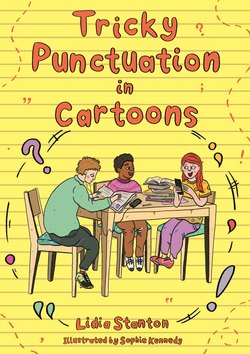Читать книгу Tricky Punctuation in Cartoons - Lidia Stanton - Страница 6
На сайте Литреса книга снята с продажи.
ОглавлениеI have used the multisensory strategies (building blocks for complex and compound sentences, thumbs for possessive apostrophes, and folded paper for contracting apostrophes) with Year 5 (aged 9–10) and Year 6 (aged 10–11) children, who worked very enthusiastically and were certainly not too young to grasp the complexities of written English language.
If introduced at any point during Key Stage 3, the book can support effective GCSE revision. In the words of the parents of a student I tutored, ‘the penny has to drop’ before the learner has the confidence to engage with structured SPAG tasks.
How does the book work?
The book assists in development of punctuation skills via enquiry-based learning (also known as problem-based learning), where cartoons are problems to work out in order to understand how punctuation works, and also to make the reader smile. The humorous drawings make the book a visual guide that demands immediate focus and provides humour. Most importantly, the cartoons assist readers in working out punctuation problems themselves before referring to written summaries of rules.
Humour is a kind of play used in the book to challenge the learner’s way of thinking about punctuation. Unexpected punch lines suddenly make the dreaded subject funny, thus less daunting. Continuous elements of surprise strengthen the process of self-discovery and consolidate learning when ‘Aha!’ moments are shared, the way jokes are passed around. The student does not need to read the book ‘from cover to cover’ but can dip in and out, as they would treat a traditional joke book.
Tricky Punctuation in Cartoons is a visual guide and workbook in one. It encourages a flexible approach to working with punctuation rules, shifting the focus away from deductive to inductive learning. This bottom-up approach enables the learner to move from something specific to more general, to detect patterns from examples and to infer rules. Instead of a rule-driven approach, it is a rule-discovery one. Using problem-based learning, the learner gradually becomes proficient in generalising their new knowledge onto other areas of literacy. Without abandoning elements of deductive teaching altogether, in order to help consolidate newly discovered knowledge, summaries and additional explanations are provided in text boxes.
English and SEN teachers are likely to agree that it is not possible to teach punctuation marks without placing them within the context of grammatical structures. In the second part of the book, alongside implicit humour, concrete props are introduced in the form of building blocks, the student’s hands and folded paper. These have positive association with play that effectively bridges the gap between the concrete and more abstract contents. The book replaces the auditory/oral instruction with a visual/practical one, putting the student in control, particularly
